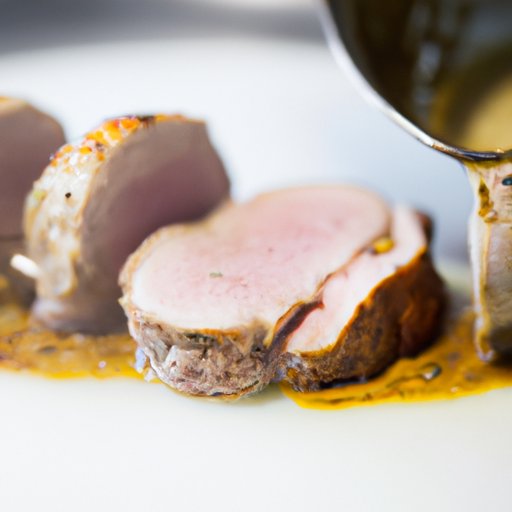
I. Introduction
Beef tenderloin is a popular cut of beef, known for its tenderness and flavor. However, cooking it can be intimidating for some home cooks. Fear not, this article will help remove the mystery and guide you through the various cooking methods. Learn how to cook beef tenderloin in the oven, on the grill, and even how to sous-vide your beef tenderloin to perfection!
II. Step-by-Step Guide: How to Cook Beef Tenderloin
The classic method of cooking beef tenderloin is in the oven. To begin, choose a high-quality cut of beef that’s approximately 4-5 pounds and oven safe. Start by generously seasoning the beef with salt, pepper, and your choice of herbs. Preheat the oven to 400°F and roast the beef for approximately 20-25 minutes per pound (or until the internal temperature reaches 125°F for medium-rare, 135°F for medium). Remove from oven and let the beef rest for 15 minutes before carving and serving.
III. Sous-Vide method
Sous-vide is a French cooking method that involves cooking food in a temperature-controlled water bath. For beef tenderloin, this ensures that the beef is cooked evenly and precisely to your desired doneness. Start by seasoning your beef, then vacuum-seal it in plastic and sous-vide it at 130°F for rare, 135°F for medium-rare, and 140°F for medium (adjust cook time as needed). After sous-vide cooking, sear the beef in a hot pan with butter or oil to create texture and color.
IV. Grilling Beef Tenderloin
Grilling beef tenderloin can be challenging, but the result is a smoky, flavorful cut of meat. Start by seasoning the beef and trimming excess fat. Preheat your gas grill to high heat or create a two-zone fire on a charcoal grill. Sear the beef on all sides for a few minutes before moving to indirect heat. Cook until the internal temperature reaches 125°F for medium-rare or 135°F for medium.
V. Oven-Roasting Technique
Similar to the classic oven method, oven-roasting involves seasoning the beef and tying it with twine before placing it in the oven. However, this technique uses a lower temperature of 325°F to gently roast the meat until it reaches the desired doneness (125°F for medium-rare or 135°F for medium).
VI. Stuffed Beef Tenderloin
A stuffed beef tenderloin is a great choice for a special occasion or a gourmet meal. Start by butterflying the beef, season it, and add your choice of stuffing to the center before rolling it back up and tying it with twine. Roast in the oven at 425°F for approximately 20-25 minutes per pound for medium-rare or 30-35 minutes for medium (internal temperature of 125°F and 135°F, respectively).
VII. Pan-Searing Beef Tenderloin
Pan-searing is a quick and easy way to cook beef tenderloin on the stovetop. Start by seasoning your beef tenderloin and selecting a heavy-bottomed pan. Heat the pan over medium-high heat and sear the beef on all sides until golden brown. Reduce heat to medium-low and continue cooking until the internal temperature reaches 125°F for medium-rare or 135°F for medium.
VIII. Sauce Pairings
Beef tenderloin pairs well with a variety of sauces. Béarnaise is a classic French sauce that is made from egg yolks, butter, shallots, tarragon, and white wine vinegar. For a hearty red wine reduction, start by deglazing the pan with red wine, add beef stock and reduce the liquid until it thickens. Bordelaise sauce is made from brown sauce and red wine, enhanced by shallots, thyme, and crushed black peppercorns.
IX. Conclusion
In conclusion, cooking beef tenderloin can seem intimidating, but with a little know-how and experimentation, anyone can create a delicious and memorable meal. From sous-vide to stuffed, there are plenty of methods to try, and plenty of sauces to pair with each. For perfectly cooked beef, remember to preheat your cooking method, season your meat generously, and use a meat thermometer to monitor the internal temperature.




